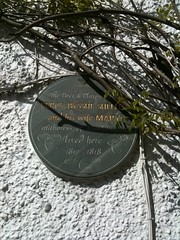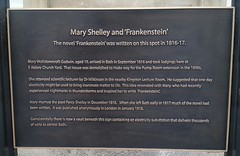Mary Shelley
Commemorated on 5 plaques
Mary Shelley 1797-1851 author of Frankenstein lived here 1846-1851
24 Chester Square, Westminster, SW1, London, United Kingdom where they lived
Percy Bysshe Shelley 1792-1822 poet & radical thinker & Mary Shelley 1797-1851 author of Frankenstein lived in a house on this site 1815-16
87 Marchmont Street, London, United Kingdom where they lived
In this churchyard lie the mortal remains of Mary Shelley author of "Frankenstein" her father William author of "Political Justice" her mother Mary author of "The Rights of Women" her son Percy, Jane his wife and the heart of Percy Bysshe her husband the poet
St Peter's, Bournemouth, United Kingdom where they lies
The poet & playwright Percy Bysshe Shelley and his wife Mary authoress of Frankenstein lived here 1817-1818
Shelley House, West Street, Marlow, United Kingdom where they lived (1816-1817)
Mary Shelley and 'Frankenstein'. The novel 'Frankenstein' was written on this spot in 1816-17. Mary Wollstonecraft Godwin, aged 19, arrived in Bath in September 1816 and took lodgings here at 5 Abbey Church Yard. That house was demolished to make way for the Pump Room extension in the 1890s. She attended scientific lectures by Dr Wilkinson in the nearby Kingston Lecture Room. he suggested that one day electricity might be used to bring inanimate matter to life. this idea resonated with Mary, who had recently experienced nightmares in thunderstorms and inspired her to write 'Frankenstein'. Mary married the poet Percy Shelly in December 1816. When she left Bath early in 1817 much of the novel had been written. It was published anonymously in London in January 1818. Coincidentally there is now a vault beneath this sign containing an electricity sub-station that delivers thousands of volts to central Bath.
The Pump Room, Abbey Chambers, Bath, United Kingdom where they wrote (1816-1817)



.jpg?width=250)


